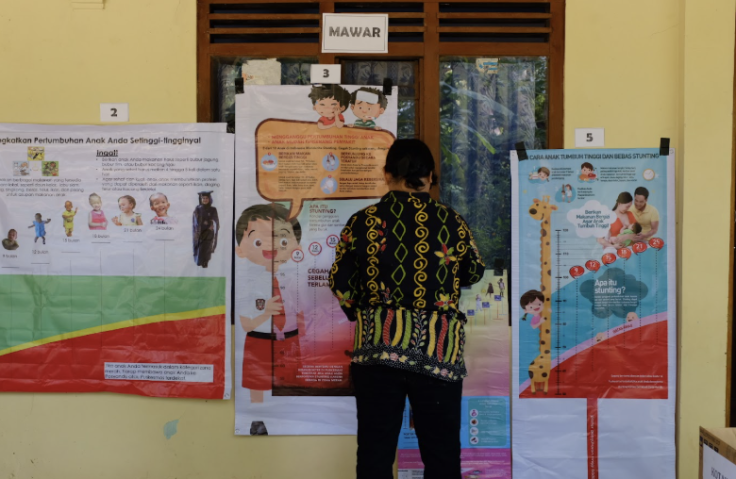
Building on existing systems: Advancing early childhood outcomes in Indonesia through collaboration and evidence

Investing in early childhood development
By age five, a child’s brain is already 85 percent developed, making the early years (0 - 6 years old) a critical window for shaping children’s cognitive, social, and emotional skills. Parents and caregivers play a key role by providing nurturing care through proper nutrition, health, safety, and early learning opportunities. Evidence from randomized evaluations shows programs promoting caregiver-child interaction improve children’s school outcomes, future employment, and earnings.
In Indonesia, where children aged 0 to 6 make up 11 percent of the population, investing in early childhood is vital. While the government supports this through health, early childhood education, and social protection programs, challenges remain in ensuring equitable access, quality, and delivery. In part, this is because those who play a crucial role in ensuring programs reach children effectively, such as caregivers, teachers, and program cadres, often have limited training and resources.
To address these gaps, J-PAL Southeast Asia organized a research-to-policy showcase bringing together policymakers, researchers, civil society organizations (CSOs), development partners, and private sector to discuss innovations for strengthening the last-mile delivery of early childhood education and development (ECED) programs.
The event revealed that despite challenges, Indonesia has a rich ecosystem of government programs and active CSOs that can be leveraged to improve early childhood outcomes. Instead of delivering new programs, there is an opportunity to build on what exists and collaborate with existing CSOs rather than start from scratch.
We’ve identified three levers of change to expand the reach and impact of ECED programs:
- Embedding child-centered programs into social assistance;
- Delivering hypercontextualized information, and;
- Improving screening and referral systems.
Embedding early childhood education and development into existing social programs
Indonesia’s social assistance systems, such as cash transfers and social protection programs, already reach millions of vulnerable families, which creates an ideal platform to integrate child-focused support. These programs not only collect valuable household data but also have delivery networks through facilitators and social workers who can be trained to share simple child development messages.
For instance, a study on Program Keluarga Harapan (PKH), Indonesia’s conditional cash transfer program, and other cash transfer research shows improvements in child nutrition, schooling, and resilience among low-income households. Such programs could also be enhanced with child-centered conditionalities, or behavioral “nudges,” to encourage outcomes such as reducing stunting and improving cognitive development. Tailoring messaging to emphasize children’s needs or adding light-touch support, like parenting guidance, can amplify their impact without creating new infrastructure.
Both government-led initiatives like PKH and community or NGO platforms offer entry points for embedding ECD interventions. By building on what already exists, policymakers can extend the reach of child-centered services more sustainably and cost-effectively, ensuring that families receive integrated support.
Hypercontextualizing information
Influencing caregivers' behavior and awareness has the potential to be a highly cost-effective way to improve early childhood outcomes. In Indonesia, these efforts are central to the National Strategy Accelerating Stunting Prevention, which promotes behavior change through national campaigns and interpersonal communication.
While information campaigns can raise awareness, experts at the event emphasized the need to move beyond one-size-fits-all approaches. A lack of language adaptation and contextual relevance often hinders caregivers’ understanding and sense of urgency. Many local organizations have valuable knowledge that can be leveraged to make messaging more meaningful. Community-based and participatory approaches, such as gathering feedback from local actors, are crucial to identify existing beliefs, misconceptions, and behavioral bottlenecks, which can then inform more targeted and adaptive communication strategies.
However, evidence shows that information alone rarely drives behavioral change and must be paired with clear actionable steps. For instance, a study in Kenya found that combining concrete information with practical guidance can significantly shift behavior, as demonstrated by a study linking such an approach to lower teen pregnancy rates.
Similarly, a study in Nusa Tenggara Timur, supported by J-PAL SEA and led by J-PAL invited researchers and co-authors, found that growth chart posters installed in the home influenced caregivers’ food choices and spending but did not lead to the adoption of ideal food portions. Providing simple, locally tailored guidance, such as clear recommendations on food portion sizes, could better empower caregivers and support stunting preventing efforts.

Screening & referral system
Early detection of growth and developmental delays can be an effective way to identify and target children who would most benefit from more intensive interventions. However, current screening services are often resource-intensive and thus are not suitable for low-resource settings. Many caregivers don’t have time or money to visit health posts (posyandu), while cadres and community health workers may be limited in number, training, or access to effective tools. Traditional methods, such as weight scales or stadiometers to measure height and weight, also tend to be inconsistent and inefficient.
During the showcase, discussions highlighted the need for a better-designed screening and referral system along with innovative solutions to address these challenges. One of the innovations that was discussed was home-based screening tools for caregivers. For example, the growth chart study mentioned above found that empowering caregivers to monitor their children’s growth using simple, home-based screening tools, accompanied by clear, step-by-step instructions, can help increase caregivers’ awareness of their children’s growth and development and promote regular health checks at home.
Additionally, it was also discussed that integrating innovative technologies, such as artificial intelligence that detect risks and provide personalized parenting recommendations, can further enhance early detection. However, these screening tools must connect with the primary health care system to enable timely referrals and ensure children receive appropriate follow-up care.

Looking ahead
Looking forward, several open questions remain:
- How can parental awareness and behavior be sustainably improved, especially among low-income households?
- In addition to the need of expanding ECED programs/network, what interventions can strengthen both supply and demand sides, while increasing participation and accessibility, particularly for rural and marginalized communities across all income levels?
- How can government, CSOs, and researchers work together to identify and address delivery challenges in early childhood programs?
- How can promising community-level interventions be adapted and integrated into existing platforms such as posyandu and cash transfer programs?
As we pursue evidence-backed answers to these questions, the showcase emphasized that both the government and CSOs already have strong programs and systems to improve early childhood outcomes. Instead of creating new initiatives, collaborations should focus on strengthening and building on these existing efforts for greater, lasting impact.
The government offers established social programs and campaigns, while CSOs provide local expertise and trusted community networks. Researchers, meanwhile, generate evidence to identify and scale effective approaches. In this regard, J-PAL aims to support these efforts by producing more evidence and policy guidance to inform early childhood policy and programming.


